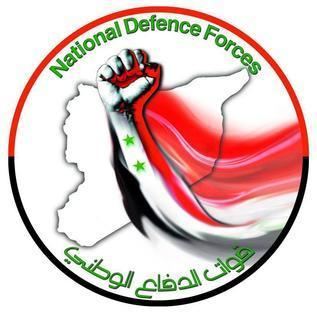Country Syria Size 90,000–100,000 Founded 2012 | Type Infantry (militia) Part of Syrian Armed Forces Allegiance Syria | |
 | ||
Active 1 November 2012 – present Garrison/HQ 3002 Damascus, Syria (main HQ)
With elements in:
Aleppo Governorate
Hama Governorate
Latakia Governorate
Tartus Governorate
Homs Governorate
al-Hasakah Governorate
Damascus Governorate
As-Suwayda Governorate
Deir ez-Zor Governorate Roles Military reserve force, Counter-insurgency | ||
The National Defence Forces (NDF) (Arabic: قوات الدفاع الوطني Quwāt ad-Difāʿ al-Watanī) is a pro-government militia, formed after summer 2012 and organized by the Syrian government during the Syrian Civil War as a part-time volunteer reserve component of the Syrian military. The NDF is made of units across various Syrian provinces, each of them consists of local volunteers willing to fight against rebels for various reasons.
Contents
Formation
By the beginning of 2013, the Syrian government took steps to formalize and professionalize hundreds of Popular Committee militias under a new group dubbed the National Defence Forces.
The goal was to form an effective, locally based, highly motivated force out of pro-government militias. The NDF, in contrast with the Shabiha forces, received salaries and military equipment from the government. Since the formation of the NDF, Shabiha members have been incorporated into its structure.
Young and unemployed men join the NDF, which some see as more attractive than the Syrian Army, considered by many of them to be infiltrated by rebels, overstretched and underfunded. A number of recruits say they joined the group because members of their families had been killed by rebel groups. In some Alawite villages almost every military-age male has joined the National Defence Force.
Others, like the Druze people of Al-Suwayda Governorate, join to protect their land from the Islamic State of Iraq and the Levant (ISIL). In late June 2015, the Syrian government began arming citizens of this governorate against ISIL, who were harassing the local population with abductions, executions, and plundering. The locals became a large and powerful NDF contingent in the governorate, including the prominent Golan Regiment.
Iranian role
The creation of the NDF was personally overseen by Iranian Quds Force commander Qasem Suleimani. Syrian security officials stated that they received assistance from Iran and Hezbollah, who both "played a key role in the formalization of the NDF along the model of the Iranian 'Basij' militia". The NDF recruits received training in urban guerilla warfare from Army of the Guardians of the Islamic Revolution (IRGC) and Hezbollah instructors at facilities inside Syria, Lebanon, and Iran, with this partnership remaining in place as of April 2015. Iran has contributed to gathering together existing neighborhood militias into a functioning hierarchy and provided them with better equipment and training. The United States government has also stated that Iran is helping build the group on the model of its own Basij militia, and that some members are being sent for training in Iran.
Role
The force acts in an infantry role, directly fighting against rebels on the ground and running counter-insurgency operations in coordination with the Syrian Army, which provides them with logistical and artillery support.
The NDF is claimed to be a secular force. For that reason, many of their members are Syrian minorities, such as Christians, Druzes, and Armenians. According to the Washington Post and the Wall Street Journal, the group has been successful, as it had played a crucial role in improving the military situation for the Syrian government forces in Syria from the summer of 2012, when many analysts predicted the downfall of Bashar al-Assad and his government.
The force was reported to be 60,000-strong as of June 2013 and grew to 100,000 by August.
Units mostly operate in their local areas, although members can also choose to take part in army operations. Others have claimed that the NDF does most of the fighting because NDF members, as locals, have a strong knowledge of the region.
Expanding role
Struggling with reliability and issues with defections, officers of the Syrian Army increasingly prefer the part-time volunteer reserves of the NDF, who they regard as more motivated and loyal, over regular army conscripts to conduct infantry operations. Recently they've been used as support infantry to advancing armored units. An officer in Homs, who asked not to be identified, said the army was increasingly playing a logistical and directive role, while NDF fighters act as combatants on the ground.
Organization
According to a report, as of February 2015 the National Defense Forces are organized under provincial commanders, and loosely overseen by a national coordinator who is reported to be Brigadier-General Ghassan Nassour, although later sources report the name of Hawash Mohammed. Local branches are deemed to act with autonomy and to be not cohesive on the provincial level, although there is little uniformity.
Provincial branches seem to be commanded by a senior officer each.
Women's section
Since January 2013, the NDF has a 500-strong women's wing called "Lionesses of National Defence", which operates checkpoints in the Homs area. The women are trained to use Kalashnikovs, heavy machine guns and grenades, and taught to storm and control checkpoints.
Training
The period of training can vary from 2 weeks to a month depending on whether an individual is being trained for basic combat, sniping, or intelligence.
Alleged infighting
On 30 April 2015, according to anti-government activists claims, infighting broke out in the Zahraa area of Homs between local NDF fighters and members of the Air Force Intelligence Directorate and Military Intelligence Directorate government security forces, who were attempting to arrest NDF leaders after complaints of lawlessness from the local population. The clashes resulted in several deaths.
